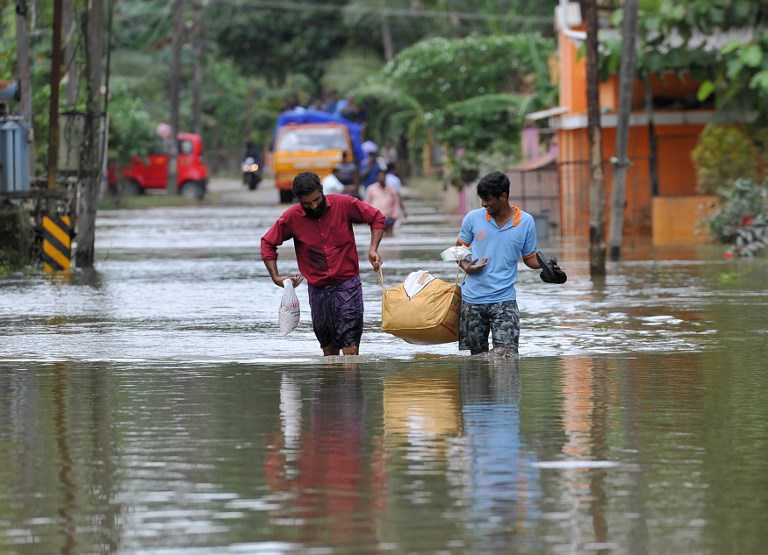
More than one million people have swarmed relief camps in India’s Kerala state to escape devastating monsoon floods that have killed more than 410 people, officials said Tuesday as a huge international aid operation gathered pace. / AFP PHOTO
by Bhuvan BAGGA
Agence France Presse
CHENGANNUR, India (AFP) — More than one million people have swarmed relief camps in India’s Kerala state to escape devastating monsoon floods that have killed about 420 people, officials said Tuesday as a huge international aid offers poured in.
People are flocking to camps as the scale of the desolation is revealed by receding waters and the military rescues more people each day.
The state government said 1,028,000 people are now in about 3,200 relief camps across the southern state. Officials said at least eight more bodies were recovered Tuesday taking the death toll to some 420 since the monsoon started in June.
Keralan authorities say they are desperate for funds and the United Arab Emirates on Tuesday promised $100 million in aid, chief minister Pinarayi Vijayan announced after telephone talks with UAE leaders.
The amount is more than the $97 million so far promised by India’s central government. Vijayan asked for a $375 million package from the government, saying the state must confront more than $3 billion in devastation.
Millions of dollars in donations have poured into Kerala from the rest of India and abroad in recent days. Other state governments have promised more than $50 million while Mukesh Ambani — Asia’s richest man according to Forbes — gave $10 million through his Reliance Industries group.
Desperate journey
Buddhist spiritual leader the Dalai Lama sent $15,000, according to the Kerala government and even India’s Supreme Court judges have donated $360 each. The British-based Sikh group Khalsa Aid International has set up its own relief camp in Kochi, Kerala’s main city, to provide meals for 3,000 people a day.
The rescue operation is now focused on the worst-hit areas such as Chengannur, where more than 60 centimetres (two feet) of water blocked many roads as more rain fell Tuesday.
Army teams said several thousand people in the town remained in homes inundated by 10 days of torrential downpours.
Relief teams reached the house of retired army officer K.G. Pillai, who said up to 2.4 metres (eight feet) of water had engulfed the house where his family had lived since 1952.
“Around 26 people moved into the first floor of our home” to take refuge, he said.
In nearby Pandanad, locals said there was a desperate shortage of drinking water and dry clothes and people implored drivers of passing vehicles for supplies.
Next to an inundated road, army major Jingy Joseph sat barefoot with her four-year-old daughter Angelina, gazing at an overflowing river.
“My daughter is safe — and that is all that matters,” Joseph told AFP. She was on duty in Punjab when her parents’ house, where her daughter was staying, was inundated last week.
“I lost all contact with them for around four days and literally had to make an appeal on Facebook for any update,” she added.
Her video became one of the most widely shared distress appeals on Indian social media.
“I can talk about it now but they were the most anxious hours. I was strong but broke when I heard my daughter was crying for milk and water at the time,” Joseph added.
She took a train ride and a flight and travelled for several hours in a car to reach her parents and move them to a safe place.
– Relief efforts –
Thousands of army, navy and air force personnel have fanned out across the state to help those stranded in remote and hilly areas.
Dozens of helicopters and even drones have been dropping food, medicine and water to cut-off villages.
Tens of thousands of people in Chengannur and surrounding towns and villages are relying on community kitchens for meals, after water from hilly districts poured down into lowland regions.
The government says that more than 10,000 kilometers (6,000 miles) of roads have been destroyed or damaged while a legislator said 50,000 houses had been wiped out.
Shashi Tharoor, a deputy from Kerala and former UN official, estimated that 50,000 houses had been destroyed.
© Agence France-Presse







